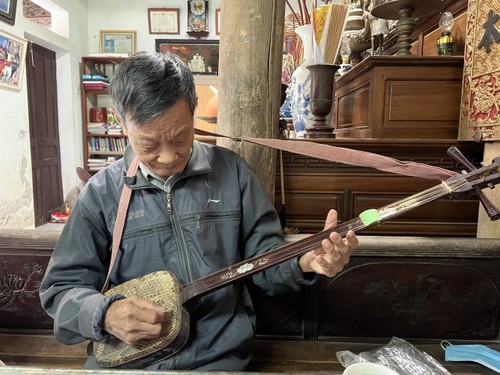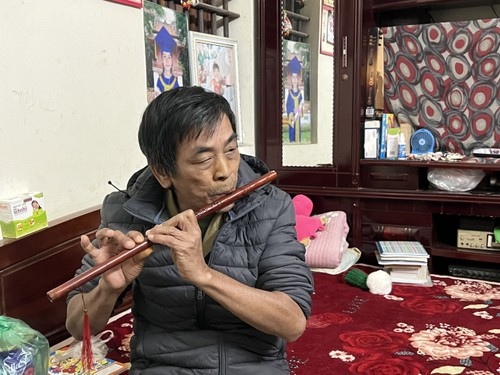"Bat am" is a popular type of music in the north of Vietnam. It usually performs at festivals, tutelary god worshipping festivals, and funerals. Long ago, it consisted of eight musical instruments made of 8 different materials - earth, metal, wood, stone, leather, gourd, bamboo, and silk. "Bat am" means eight different musical instruments with eight different timbres.
 Artisan Vu Quang Lien fine-tunes a musical instrument in the "Bat am" orchestra of Tri Chi hamlet. (Photo: VOV) Artisan Vu Quang Lien fine-tunes a musical instrument in the "Bat am" orchestra of Tri Chi hamlet. (Photo: VOV) |
At the age of 86, artisan Vu Quang Lien is still passionate about preserving and teaching traditional musical instruments, especially to the young people of Tri Chi hamlet, Phu Xuyen district, Hanoi. Lien said Phu Xuyen’s Bat am is based on Nha Nhac, Hue royal court music.
“My village had a tradition of making palm-leaf raincoats. While in Hue to sell the raincoats, our predecessors had opportunities to attend traditional festivals there and enjoyed Hue royal court music. When they came home, they invented different kinds of musical instruments made from bamboo, coconut, and horsehair. Those musical instruments are still being used today.”
The villagers also invented a "Bat am" orchestra, which, despite the influence of Hue royal court music, still had the rustic flavor of rural areas in the north. For many years, Bat am music was played at the communal house for all rituals, festivals, and Lunar New Year celebrations in Tri Chi village, said Mr. Lien.
“In a 'Bat am' orchestra, the flute is the lead sound that other instruments need to follow to create a perfect harmony.”
 Ngo Van Dai plays the flute for the Bat am orchestra in Tri Chi hamlet (Photo: VOV) Ngo Van Dai plays the flute for the Bat am orchestra in Tri Chi hamlet (Photo: VOV) |
Many free "Bat am" music classes have been opened in Tri Chi hamlet.
“It took me 5 years to play musical instruments. First, I learned to play the flute. Then, it took me 3 years to learn to play the erhu,” said Ngo Van Dai, a member of the local "Bat am" orchestra.
“It takes 3 years to master the skills needed to play ritual drums because the player needs to accompany other musical instruments. It’s more difficult than playing festive drums,” said member Vu Xuan Thang.
According to Mr. Vu Quang Dung of the Vietnam Academy of Social Sciences, the Tri Chi artists have been a great inspiration in raising people’s awareness of the importance of preserving Vietnam’s cultural heritages.
“I’m delighted that the younger generation is continuing the tradition. The local authorities need to focus more on young people and get them involved in local festivals, which is the soul of tradition and culture,” he said.